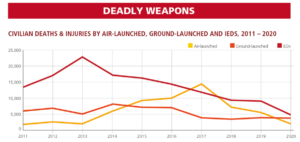The research, based on a decade of work by Action on Armed Violence, strengthens calls for restrictions on explosive weapons
Nine out of ten people killed and injured by explosive weapons in cities are civilians, a new report has found, in stark findings likely to increase pressure on governments to curb the use of explosive weapons in urban areas.
In total the Action On Armed Violence (AOAV) report, which surveyed explosive violence across the globe over a ten-year period, found that 91 percent of those killed and injured when explosive weapons were used in cities were civilians. In other, less densely populated areas, the rate fell to 25 percent.
“The evidence is absolutely clear and unequivocal,” Iain Overton, the executive director of AOAV, said. “When explosive weapons are used in towns and cities, civilians will be harmed. (That is) as true as it is today in Gaza as it was a decade ago in Iraq and beyond.”
The report tracked 238,892 civilians killed and injured by explosive weapons over the past decade in 123 countries and territories, using open-source monitoring of English-language media.
It found that improvised explosive devices were responsible for more than half of all civilian casualties, while airstrikes and other aerial assaults were responsible for 23 percent and ground-launched explosive weapons 21 percent.
The most deadly single incident occurred in Somalia in October 2017, when more than 500 people were killed in twin bomb blasts in the capital Mogadishu. The Islamist militant group Al-Shabaab was believed to be behind those explosions.
The most deadly air strike came in 2016 when the Saudi Arabian-led coalition struck a funeral procession in Yemen, killing nearly 140 people and wounding a further 600.
Reducing civilian harm
Overton argued the report would strengthen efforts to restrict the use of explosive weapons in populated areas (EWIPA).
Ireland has spearheaded efforts in recent years for action on EWIPA, releasing a draft document earlier this year. It stresses that even when militaries try to limit the impact of their strikes in urban areas, the closely populated nature of cities makes civilian harm inevitable.
Belgium last month became the first country to adopt a resolution against the use of EWIPA after a vote by the federal parliament’s National Defense Commission.
In October Airwars, together with Dutch organisation PAX, released a joint report examining the dire and long-lasting effects of explosive weapons on civilian populations in urban areas in recent international military campaigns in Mosul, Raqqa and Hawijah. The report was launched in a virtual event by Ambassador Michael Gaffey of Ireland.
Beyond the civilians directly harmed, military campaigns can leave the infrastructure of cities devastated for years.
During the 2016-17 campaign by the US-led coalition to remove the so-called Islamic State from Mosul an estimated 9,000 civilians were killed, while up to 80 percent of buildings in the centre of the city were destroyed.
In June 2019, the UN International Organisation for Migration reported that entire neighbourhoods of Mosul had yet to be rebuilt and that a lack of essential services and poor sanitation were still threatening public health. Additionally, unexploded bombs, missiles, rockets and shells prevented civilians from returning to the city.
“The negotiation of the political declaration (on EWIPA) is an opportunity to set new standards against the use of heavy explosive weapons in towns and cities, to better protect civilians and vital civilian infrastructure located in cities,” said Laura Boillot, Coordinator of the International Network on Explosive Weapons.
The AOAV report also found a decrease in civilian harm in 2020, a trend also noted by Airwars’s recent annual report. Factors that explain this include significant breakthroughs in conflicts in Libya and Syria, as well as the knock-on implications of the COVID-19 pandemic.


